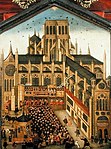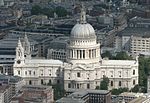Paternoster Row

Paternoster Row was a street in the City of London that was a centre of the London publishing trade, with booksellers operating from the street. Paternoster Row was described as "almost synonymous" with the book trade. It was part of an area called St Paul's Churchyard. The street was devastated by aerial bombardment during the World War II. In 2003 the street was replaced with Paternoster Square, the modern home of the London Stock Exchange, although a City of London Corporation road sign remains in the square near where Paternoster Row once stood.As far back as the 12th century, the road was known as Paternoster Row, as it was the main place in London where Paternoster beads were made by skilled craftsmen. The beads were popular with illiterate monks and friars at the time, who prayed 30 Paternoster prayers (Latin for "Our Father") three times a day as a substitute for the 150 psalms recited a day by literate monks.
Excerpt from the Wikipedia article Paternoster Row (License: CC BY-SA 3.0, Authors, Images).Paternoster Row
Paternoster Row, City of London
Geographical coordinates (GPS) Address Nearby Places Show on map
Geographical coordinates (GPS)
| Latitude | Longitude |
|---|---|
| N 51.514722222222 ° | E -0.098055555555556 ° |
Address
RBS
Paternoster Row
EC4M 7EJ City of London
England, United Kingdom
Open on Google Maps










